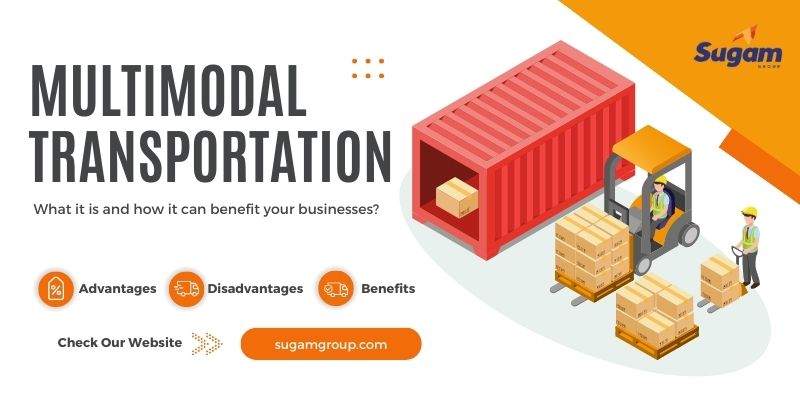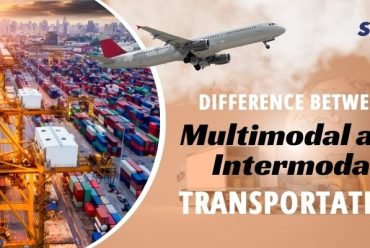Multimodal Transportation: What It Is and How It Can Benefit Your Businesses?
In today’s global marketplace, businesses are facing increasing pressure to optimize their supply chain operations and reduce transportation costs while improving efficiency and customer satisfaction. Multimodal transportation system, which involves using multiple modes of transportation to move goods from one point to another, is becoming an increasingly popular solution. In this blog, we will explore what multimodal transportation is, its advantages and disadvantages, and how businesses can benefit from it.
What is Multimodal Transport?
Multimodal transportation is a system of moving cargo or goods through different modes of transportation such as road, rail, sea, and air. In this system, different modes of transportation are used to move cargo or goods from one point to another. For example, cargo can be transported by truck to a seaport, then loaded onto a ship and transported across the ocean, and then offloaded onto a train for final delivery. Here are the important points regarding the importance of multimodal transportation for businesses:
Cost savings:
Multimodal transportation system can provide cost savings for businesses by combining different modes of transportation, taking advantage of cheaper modes of transportation for certain legs of the journey, and optimizing transportation routes. For example, businesses can use rail cargo service for long-haul routes and then switch to trucks for shorter distances, thereby reducing overall transportation costs.
Improved efficiency:
Multimodal transportation can improve efficiency by reducing transit times and optimizing logistics. By using the most efficient modes of transportation for each leg of the journey, businesses can improve overall efficiency and reduce unnecessary movements. For instance, using air transportation for time-sensitive deliveries and sea transportation for bulk cargo can optimize the transportation process and save time.
Increased customer satisfaction:
Multimodal transportation can lead to increased customer satisfaction by reducing transit times, improving reliability, and providing better tracking and communication. By using a variety of transportation modes, businesses can improve the predictability of shipments and meet customer expectations. Additionally, businesses can use technology to track shipments and provide real-time updates to customers.
Reduced risk:
Multimodal transportation can help businesses reduce risk by diversifying transportation modes and routes. By using multiple transportation modes, businesses can reduce the risk of disruptions and delays caused by natural disasters, labor strikes, or geopolitical unrest. Additionally, by using different routes, businesses can avoid congestion and optimize transportation schedules.
Improved sustainability:
Multimodal transportation can help businesses achieve their sustainability goals by reducing carbon emissions and environmental impact. By optimizing transportation routes and using the most efficient modes of transportation, businesses can reduce carbon emissions and minimize their environmental footprint. Additionally, businesses can leverage technology to track emissions and improve their sustainability performance.
Advantages of Multimodal Transportation:
Multimodal transportation offers businesses a wide array of benefits, which encompass cost-effectiveness, expedited transit times, mitigated risks and damages, enhanced flexibility and scalability, and bolstered sustainability practices. By strategically incorporating various modes of transportation, enterprises can streamline and optimize their third-party logistics (3PL) supply chain operations, resulting in heightened overall efficiency and elevated levels of customer satisfaction.
Cost-effective:
The strategic amalgamation of diverse transportation modes empowers businesses to curtail transportation expenditures significantly. This approach enables them to capitalize on more economical transportation options for specific segments of their logistical journeys, thereby fostering considerable savings.
Faster transit times:
Employing the most efficient modes of transportation tailored to the unique requirements of each logistical phase leads to expedited overall transit times. This acceleration not only enhances the supply chain’s performance but also elevates customer satisfaction levels through timely deliveries.
Reduced risks and damages:
Multimodal transportation’s inherent flexibility shines when it comes to risk mitigation. By diversifying transportation modes and routes, businesses can effectively lower their vulnerability to potential disruptions and damages stemming from natural disasters, labor strikes, geopolitical turmoil, and unforeseen circumstances.
Increased flexibility and scalability:
Multimodal transportation engenders newfound flexibility and scalability within supply chain management. Businesses can seamlessly adapt to fluctuating market dynamics and evolving customer demands, ensuring they remain agile and responsive in a rapidly changing business landscape.
Improved sustainability:
Strategic route optimization and the utilization of the most eco-friendly transportation modes enable businesses to curtail carbon emissions and minimize their environmental footprint. This proactive approach aligns with corporate sustainability goals, contributing to a greener, more responsible approach to logistics and supply chain operations.
Disadvantages of Multimodal Transportation:
While multimodal transportation offers numerous benefits, it also comes with certain disadvantages. These include complex Warehouse logistics, potential for delays, increased risk of damage or loss, regulatory challenges, and increased need for coordination. Businesses must be aware of these potential challenges and take appropriate steps to mitigate them in order to successfully implement multimodal transportation solutions.
Complex Warehouse logistics:
Effectively managing multiple transportation modes and harmonizing their intricate schedules and labyrinthine routes necessitates a substantial degree of meticulous planning and allocation of resources. The complexities entailed in orchestrating this multifaceted logistical symphony demand careful attention.
Potential for delays:
The integration of multiple transportation modes inevitably introduces the potential for delays, stemming from logistical intricacies or unforeseen circumstances. These delays can have repercussions on supply chain efficiency and necessitate proactive strategies to mitigate their impact.
Increased risk of damage or loss:
The utilization of multiple transportation modes and the consequent handling procedures can amplify the inherent risk of damage or loss during transit. Vigilant risk management practices are imperative to safeguard valuable cargo throughout its journey.
Regulatory challenges:
Multimodal transportation involves complying with various regulations and laws across different transportation modes and countries. This intricate web of regulatory compliance adds layers of complexity to logistics and can escalate compliance-related costs. Careful adherence and a comprehensive understanding of these regulations are essential.
Increased need for coordination:
Given that multimodal transportation involves the orchestration of multiple stakeholders and transportation modes, the paramount importance of seamless coordination and robust communication becomes evident. Businesses must be prepared to invest additional resources and effort into enhancing coordination and management to ensure the smooth operation of their multimodal logistics.
Benefits of Multimodal Transportation:
The benefits of multimodal transport are numerous and can help businesses optimize their supply chain operations, reduce costs, improve efficiency and customer satisfaction, and meet sustainability goals.
Cost-effectiveness:
Multimodal transportation empowers businesses to strategically optimize their supply chain procedures, efficiently curbing transportation expenses by making astute choices regarding the most budget-friendly transportation modes for distinct segments of the journey.
Faster transit times:
Through judiciously selecting the most expeditious transportation modes for each leg of the journey, multimodal transportation works its magic in shortening overall transit times, culminating in heightened customer contentment stemming from punctual deliveries.
Reduced risks and damages:
The multi-pronged approach of incorporating diverse transportation modes and routes serves as a shield, fortifying businesses against potential disruptions and damages stemming from the caprices of nature, labor strikes, or geopolitical unrest.
Increased flexibility and scalability:
Multimodal transportation grants businesses a newfound degree of adaptability and scalability in their supply chain management efforts, allowing them to nimbly navigate shifting market dynamics and cater to evolving customer needs.
Improved sustainability:
Crafting smarter transportation routes and harnessing the potency of eco-friendly transportation modes empowers businesses to markedly shrink their carbon footprint and environmental impact. This virtuous pursuit aids in fulfilling sustainability targets.
Access to new markets:
By leveraging an array of transportation methods, businesses can seamlessly tap into fresh markets and broaden their customer base, thereby expanding their reach and influence.
Improved visibility and control:
Multimodal transportation equips businesses with heightened visibility and superior control over their supply chain operations. This invaluable vantage point is achieved through meticulous shipment tracking across diverse transportation modes, enabling real-time updates to be relayed to customers.
Enhanced security:
Multimodal transportation acts as a fortress of security for high-value or sensitive goods by deploying specialized equipment, fortified security protocols, and vigilant monitoring systems, assuring clients of the utmost protection throughout the journey.
Why Choose Multimodal Transportation From Sugam Group?
Sugam Group is renowned as the best Multimodal Transport Operators in India. In multimodal transportation, it combines rail, air, sea, and land transport modes that facilitates convenient shipping across countries. Sugam Group covers all major land and rail routes across India and other SAARC regions. It also offers FTL, LTL, and ODL as per shipping requirements which prove to be a cost effective solution. All in all transporting from Sugam Group is a big win in terms of cost, convenience, delivery and safety.
Being in the industry for 50 years, we provide excellence in their logistics services with well established international boundaries of transportation & 3PL solutions across India, Nepal, Bhutan & Bangladesh. With over 1 Lac customers annually, we have 1,00,000+ sq. ft. area of warehouse space and 250+ offices in SAARC region along with 500+ GPS enabled vehicles.
If you have any questions, feel free to call 1800112243 or write to us on sales@sugamgroup.com
FAQs:
What is multimodal transportation?
Multimodal transportation refers to the use of multiple modes of transportation, such as road, rail, air, and sea, to move goods from one location to another. This approach provides businesses with greater flexibility and efficiency in managing their supply chain operations.
What is an example of a multimodal transport company?
There are several examples of multimodal transport companies, including DHL Global Forwarding, Kuehne + Nagel, DB Schenker, Maersk Line, and FedEx Trade Networks.
What is multimodal transportation in India?
In India, multimodal transportation is becoming increasingly popular as businesses seek to optimize their supply chain operations and reduce costs. The government has launched several initiatives to promote multimodal transportation, including the Sagarmala Programme, which aims to improve port connectivity and promote coastal shipping, inland waterways, and hinterland connectivity. The Indian Railways is also developing a dedicated freight corridor network to enable seamless movement of goods across the country.
What are the benefits of multimodal transportation?
Multimodal transportation provides several benefits to businesses, including cost-effectiveness, faster transit times, reduced risks and damages, increased flexibility and scalability, improved sustainability, access to new markets, improved visibility and control, and enhanced security.
What is multimodal transportation?
Multimodal transportation system involves the use of multiple modes of transportation, such as trucks, trains, ships, and planes, to move goods from one point to another. This approach provides businesses with greater flexibility and efficiency in managing their supply chain operations.
Is multimodal transportation beneficial to the industry?
Yes, multimodal transportation is beneficial to the industry as it helps businesses to optimize their supply chain operations, reduce costs, and improve their environmental sustainability. It also provides greater flexibility in responding to changing market demands and expands access to new markets.
What are the benefits of multimodal integration?
Multimodal integration provides businesses with the ability to seamlessly integrate different modes of transportation into a single, streamlined supply chain. This results in greater efficiency, lower costs, and faster transit times. It also provides businesses with greater flexibility to respond to changes in demand and reduce the risk of disruptions to their supply chain operations.







No Comments